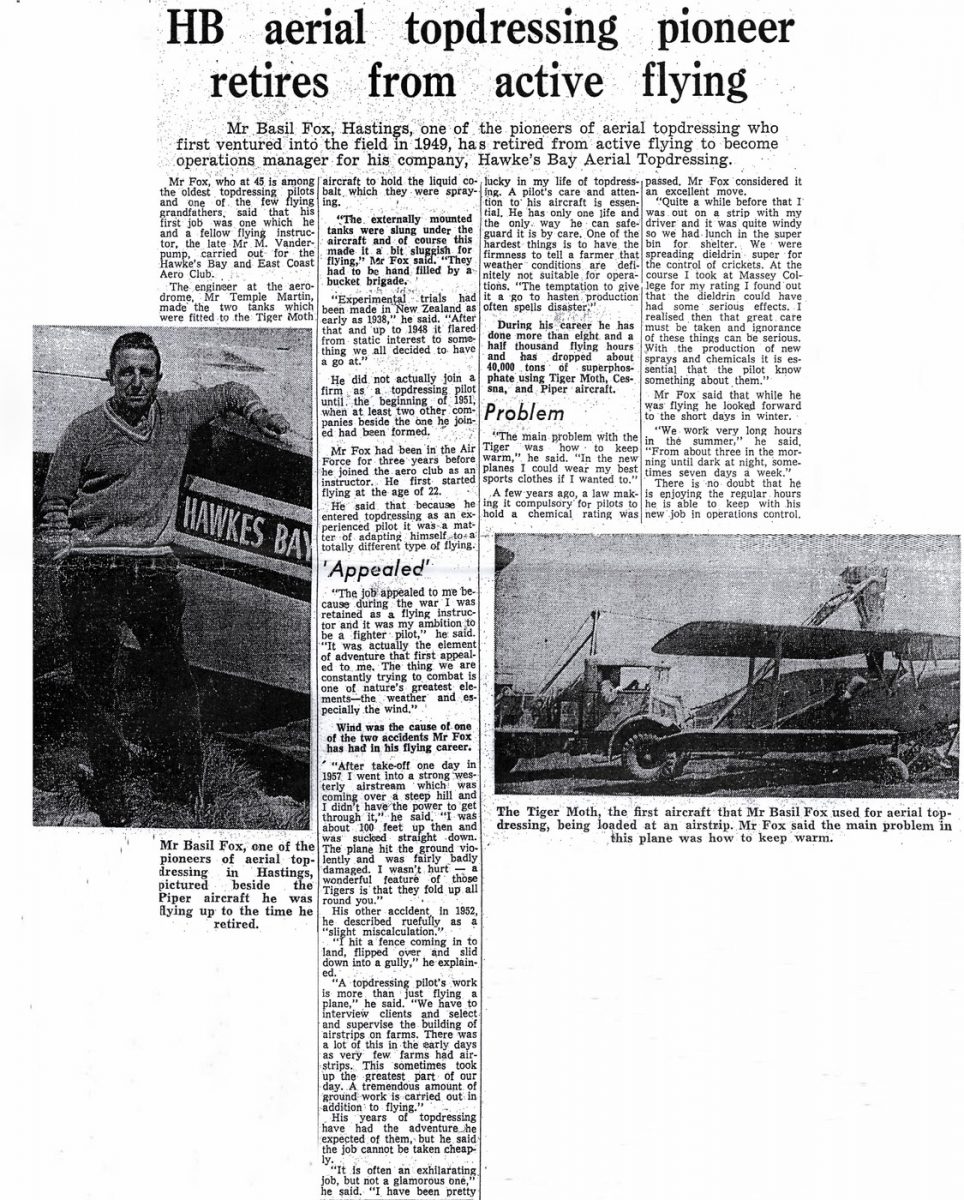HB aerial topdressing pioneer retires from active flying
Mr Basil Fox, Hastings, one of the pioneers of aerial topdressing who first ventured into the field in 1949 has retired from active flying to become operations manager for his company, Hawke’s Bay Aerial Topdressing.
Mr Fox, who at 45 is among the oldest topdressing pilots and one of the few flying grandfathers said that his first job was one which he and a fellow flying instructor, the late Mr M. Vanderpump, carried out for the Hawke’s Bay and East Coast Aero Club.
The engineer at the aerodrome, Mr Temple Martin, made the two tanks which were fitted to the Tiger Moth aircraft to hold the liquid cobalt which they were spraying.
“The externally mounted tanks were slung under the aircraft and of course this made it a bit sluggish for flying,” Mr Fox said. “They had to be hand filled by a bucket brigade.
“Experimental trials had been made in New Zealand as early as 1938,” he said. “After that and up to 1948 it flared from static interest to something we all decided to have a go at.”
He did not actually join a firm as a topdressing pilot until the beginning of 1951, when at least two other companies beside the one he joined had been formed.
Mr Fox had been in the Air Force for three years before he joined the aero club as an instructor. He first started flying at the age of 22.
He said that because he entered topdressing as an experienced pilot it was a matter of adapting himself to a totally different type of flying.
‘Appealed’
“The job appealed to me because during the war I was retained as a flying instructor and it was my ambition to be a fighter pilot.” he said. “It was actually the element of adventure that first appealed to me. The thing we are constantly trying to combat is one of nature’s greatest elements – the weather and especially the wind.”
Wind was the cause of one of the two accidents Mr Fox has had in his flying career.
“After take-off one day in 1957 I went into a strong westerly airstream which was coming over a steep hill and I didn’t have the power to get through it,” he said. “I was about 100 feet up then and was sucked straight down. The plane hit the ground violently and was fairly badly damaged. I wasn’t hurt – a wonderful feature of those Tigers is that they fold up all round you.”
His other accident in 1952, he described ruefully as a “slight miscalculation.”
“I hit a fence coming in to land, flipped over, and slid down into a gully,” he explained.
“A topdressing pilot’s work is more than just flying a plane,” he said. “We have to interview clients and select and supervise the building of airstrips on farms. There was a lot of this in the early days as very few farms had airstrips. This sometimes took up the greatest part of our day. A tremendous amount of ground work is carried out in addition to flying.”
His years of topdressing have had the adventure he expected of them, but he said the job cannot be taken cheaply.
“It is often an exhilarating job, but not a glamorous one,” he said. “I have been pretty lucky in my life of topdressing. A pilot’s care and attention to his aircraft is essential. He has only one life and the only way he can safeguard it is by care. One of the hardest things is to have the firmness to tell a farmer that weather conditions are definitely not suitable for operations. “The temptation to give it a go to hasten production often spells disaster.”
During his career he has done more than eight and a half thousand flying hours and has dropped about 40,000 tons of superphosphate using Tiger Moth, Cessna, and Piper aircraft.
Problem
“The main problem with the Tiger was how to keep warm,” he said. “In the new planes I could wear my best sports clothes if I wanted to.”
A few years ago, a law making it compulsory for pilots to hold a chemical rating was passed. Mr Fox considered it an excellent move.
“Quite a while before that I was out on a strip with my driver and it was quite windy so we had lunch in the super bin for shelter. We were spreading dieldrin super for the control of crickets. At the course I took at Massey college for my rating I found out that the dieldrin could have had some serious effects. I realised then that great care must be taken and ignorance of these things can be serious. With the production of new sprays and chemicals it is essential that the pilot know something about them.”
Mr Fox said that while he was flying he looked forward to the short days in winter.
“We work very long hours in the summer,” he said. “From about three in the morning until dark at night, sometimes seven days a week.”
There is no doubt that he is enjoying the regular hours he is able to keep with his new job in operations control.
Photo captions –
Mr Basil Fox, one of the pioneers of aerial topdressing in Hastings, pictured beside the Piper aircraft he was flying up to the time he retired.
The Tiger Moth, the first aircraft that Mr Basil Fox used for aerial topdressing, being loaded at an airstrip. Mr Fox said the main problem in this plane was how to keep warm.












Do you know something about this record?
Please note we cannot verify the accuracy of any information posted by the community.